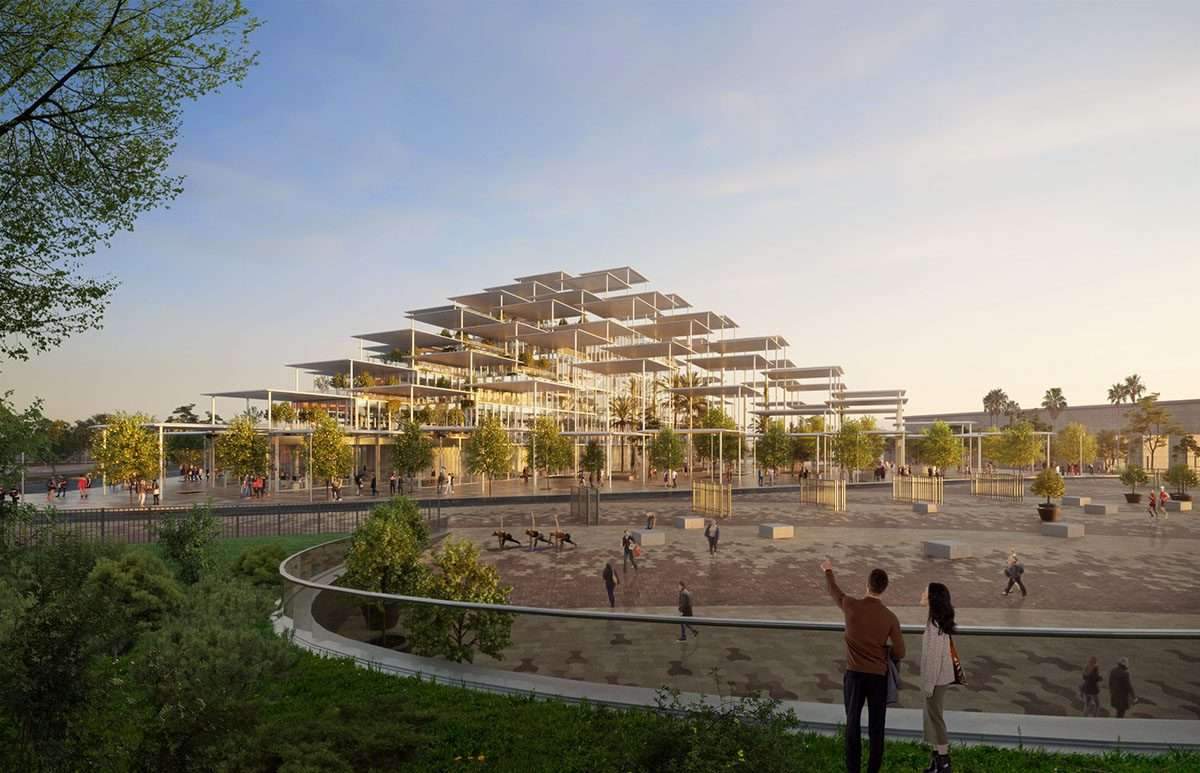Design of a research center with sunshades in Seville by BIG,
After winning a competition to design a new research center in Seville, Spain,
Bjarke Ingels Group (BIG) began designing the center.
The center consists of a cloud of solar panels hovering above it and forming a new research center,
called the Joint Research Center (JRC Sevilla).
The complex has an area of about 9,900 square metres,
and the design takes cues from the vernacular architecture of Seville, the southern Spanish city.
The new research center has been designed for
the European Commission and is located on the site of the former Sevilla Expo ́92 on Isla de la Cartuja.

Design goals
It aims to achieve the city of Seville’s goal of becoming a global sustainability benchmark by 2025 and the local vision of the eCitySevilla project -.
This intends to decarbonize and convert the island of La Cartuja to 100% renewable energy sources.
BIG’s new design scheme also aims to fulfill the vision of the new Bauhaus Initiative with its sustainability principles.
The Solar Cupola, will house 12 research units and will support public and private outdoor spaces,
an international design competition began in 2021 and 66 offices are competing for the project.
JRC Sevilla is expected to start in 2024.
The NEB Lab aims to create favorable conditions for green transformation and drive a tangible transformation on the ground,
and the new building of the JRC Seville site represents an ideal opportunity for the group.
The futuristic building will be one of the first examples of architecture entirely inspired by the new European Bauhaus values.
This is while maximizing energy efficiency and life cycle sustainability,
an issue of paramount importance today.

Design Features
Inspired by the design of the shaded squares and streets of Seville, BIG covers the entire project site with a cloud of solar canopies,
protecting the plaza, garden and research building beneath, alluding to the typical pergolas of Seville.
BIG has emphasized, that the blinds are made of lightweight PV sheets and supported by a thicket of thin columns.
A distinctive rooftop landscape will be created, the rooftop cascades cascading from the center of the site
to the height of human scale in its surroundings and forming a variety of public spaces beneath.
By designing the Joint Research Center in Seville,
the designers attempted to allow the building’s sustainable performance to drive an architectural aesthetic.
This leadership not only makes the building perform better,
but also makes it more habitable and more beautiful, creating a new ecological Andalusian language.
The new JRC building is positioned diagonally across the site to connect the JRC directly to the Jardin Americano Riverfront
and the Torre Seville Market in a seamless, continuous public space representing a plaza and park.
The diagonal placement of the building also creates a new public plaza on one side of the building and a private garden for the JRC community on the other.
So that people can feel the permeability and shape of the curtains when walking around under the curtains.
Design of a research center with sunshades in Seville by BIG
The floorboards of the Research Center recede as the building rises,
creating a series of terraces and shaded outdoor spaces for rest, relaxation and informal meetings with city views.
The designers also decided to combine the functions of the new center with the public program and amenities,
on the inside, including dining, a conference center and social spaces on the ground floor.
Offices and research units occupy the upper floors due to privacy and security,
while collaborative workplaces face the square.

Project Views
The highly focused workspaces overlook the park,
as the proposed scheme is designed to be completely flexible and adaptable according to any future needs of the JRC.
The two inclined spaces connect all levels of the building, following the building’s geometry and modularity,
encouraging physical movement as well as social interaction and informal meetings.
JRC staff and visitors are more likely to climb the stairs, increasing the opportunity for meetings between colleagues.
Passive design will also be ensured by the building’s shallow floor plate and continuous shading under the pergola cloud.
While at the same time the natural cross ventilation, optimum lighting quality is maintained through the shape of the design.
This reduces the energy consumption typically used in artificial lighting, air conditioning and mechanical ventilation.
The design is also set to be built using locally sourced materials, such as limestone, wood, and ceramic tiles.
The structure of the building is intended to be low-carbon concrete, which reduces by up to 30%, typical CO2 emissions.
While the pergola cloud is made of recycled steel, other elements, such as gardens,
greenery from the area, and water elements in the outdoor environment,
seek to reduce or eliminate the heat island effect and create a comfortable microclimate.


 العربية
العربية